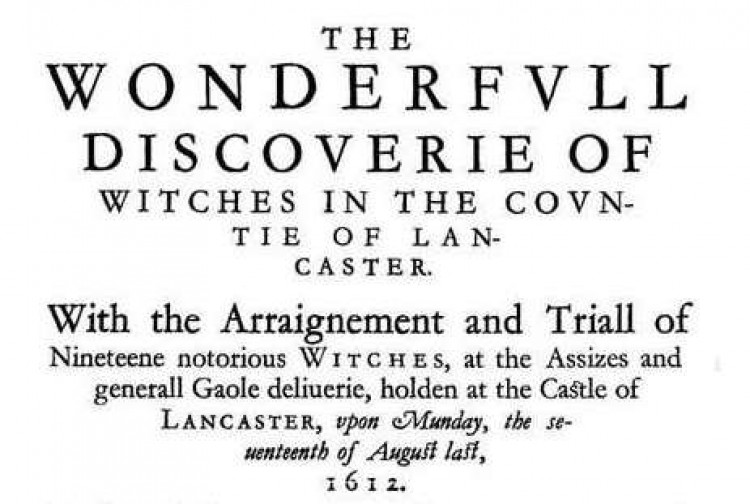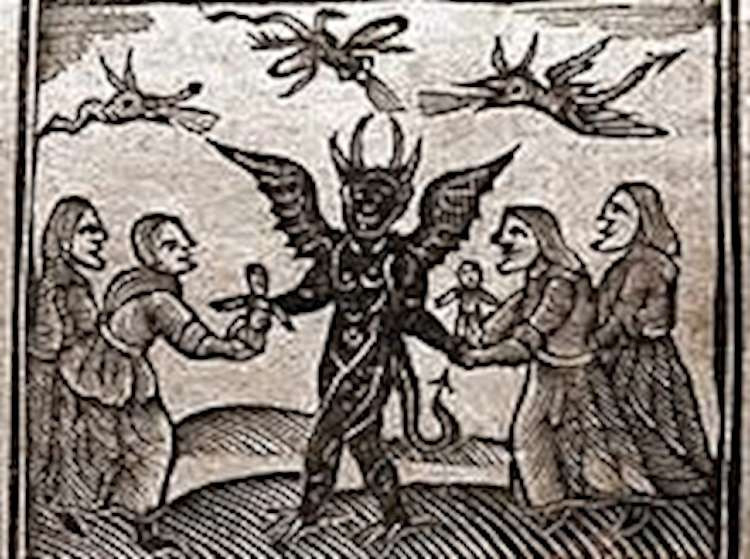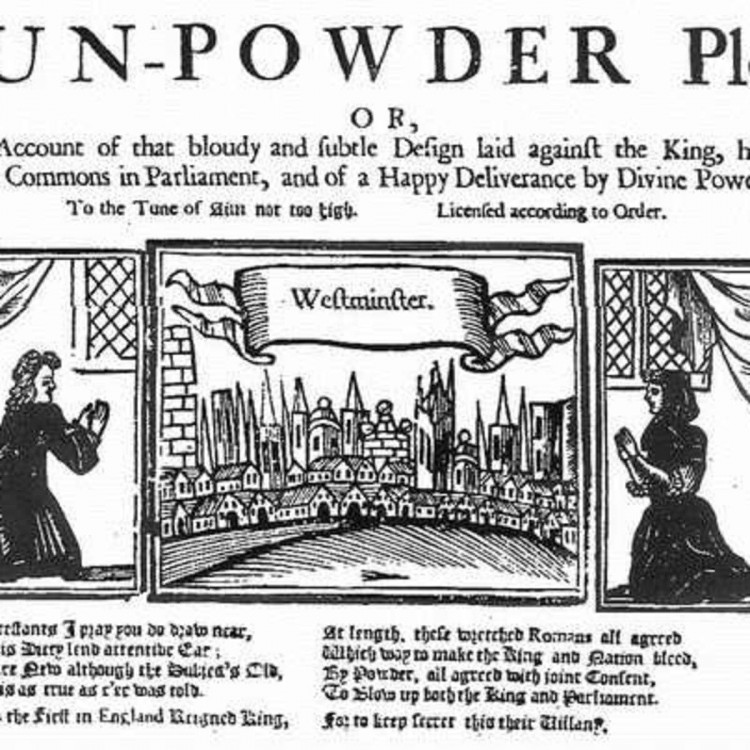The Lancashire witch trial of 1612: a longer read anticipating Halloween and November 5th
By Mark Gorton 25th Sep 2022
By Mark Gorton 25th Sep 2022

This feature has little to do with Heswall, but much to do with our collective fascination with witchcraft. It's the story of the murders of the Lancashire 'witches'.
Britain's most destructive single witch hunt took place in Lancashire in 1612. It was our equivalent of Salem: twenty innocent men and women were tried; ten were executed; an eleventh had already died in prison.
The trial is remarkable for two reasons: first, it heard bizarre evidence of feuds between warring families of witches, of souls sold to the Devil and supernatural murders; second, it appears to have been recorded in unique detail for posterity by clerk Thomas Potts. His account was published as The Wonderful Discoverie of Witches in the Countie of Lancaster.

The witch hunter was local Puritan magistrate, Roger Nowell. Serving God, King and himself, Nowell manipulated witnesses and orchestrated events in court in order to frame the defendants. Potts re-arranged the evidence for publication to justify the verdicts and cover up what had really happened.
Nowell was the stage manager of an extraordinary show trial. Potts was his spin doctor.
On Thursday August 20, 1612, ten of the so-called Lancashire witches were hanged at Lancaster Gaol. They were Alizon, Elizabeth and James Device; Anne Whittle (known locally as Chattox because of her incessant chattering); Anne Redfearn; Isobel Robey; Katherine Hewitt; John and Jane Bulcock; and Alice Nutter. An eleventh witch, Elizabeth Device's mother, Elizabeth Southerns (alias Old Demdike), had died earlier in custody.
This was a time when the remains of Catholicism in Lancashire had merged with folk beliefs and superstitions; a time when the poor and desperate might call on a local woman to use arcane ritual to treat a sick cow; and a time when the King, James I, had published a manual to aid God-fearing souls seek out and destroy those who practiced the black arts. James believed he had been the target of a satanic conspiracy in Scotland – his book, Demonology, would help expose any similar plots elsewhere in his kingdom.

The story begins on March 18. A pedlar, John Law, refuses to sell pins to teenager Alizon Device, possibly because Law believes she has no money with which to pay. Alizon curses him and Law falls to the ground, lamed. Later Alizon visits the stricken Law and begs for forgiveness, which is granted.
John Law's son, Abraham, reports Alizon's confession to the local magistrate and wealthy landowner, Roger Nowell. Nowell interviews Alizon, her mother Elizabeth and brother James. Alizon is taken into custody.
This was the trigger for a most extraordinary outpouring of the fantastical and the grotesque. Taking the account of Thomas Potts at face value, sworn testimony during the trial revealed that this part of Lancashire – the Forest of Pendle – was no stranger to witches' familiars that might be a large, shape-shifting dog; a bear; a cloven hoofed man; or a white foal.
It was a place where witches murdered at will by curse and magic and fornicated with the Devil. And, above all, it was a place where the accused would be condemned by incredible evidence – evidence given by neighbours, friends and even by a small child in the shape of nine year old Jennet Device, the Crown's most devastating witness. Her testimony would help condemn her own family and other witches to death by slow strangulation on the gallows.

Among those fatally tainted by little Jennet was Alice Nutter. Jennet would place Alice and several of the other accused at a Good Friday meeting at Malkin Tower, which sounds like a grand house but was nothing of the sort. The gathering was described in court as a witches' Sabbath. Alice never confessed and remained silent to the end. At her execution, writes Thomas Potts, "she died very impenitent, insomuch as her own children were never able to move her to confess any particular offence, or declare any thing, even in Articulo Mortis, which was a fearful thing to all that were present, who knew she was guilty."
Alice was not alone in refusing to confess; but what does make her extraordinary, the enigma of the 1612 trial, was her social background. She was a gentlewoman who owned land and had servants. Furthermore, there is much evidence to suggest that Alice was also a recusant and a prominent one at that; in fact it is possible the Good Friday gathering at which she was present was more Catholic Mass than witches' Sabbath. Alice's faith was another reason why she was framed.
Nowell would lead a ruthless investigation and, like some master dramatist, weave an overwhelming case from the bizarre spiritual threads of his day. This would permit him to consolidate his local power and reveal his loyalty to the King and his divine wisdom. It was a win-win situation for the magistrate turned witch hunter.
Nowell struck lucky when Alizon Device cursed John Law and, by extraordinary coincidence, the unfortunate pedlar collapsed, displaying all the symptoms of a stroke. Law's condition seems to have persuaded Alizon that she was indeed responsible, that she had invoked a malign power. Under the guidance of Nowell she would make a full confession.
Alizon's confession immediately implicated her own family; and from then on it was relatively easy for Nowell to project a world in which they and others had been contaminated by evil. We will never know what pressure or promises made young Jennet testify as she did, but her words in court were damning. She had seen her mother Elizabeth's familiar, a brown dog called Ball, at the family home on several occasions, and she reported that Ball had assisted in the murder of three men.
In court her mother railed and screamed, imploring Jennet to be quiet. Writes Potts: "The said Jennet Device…was commanded to stand up to give evidence against her mother, Prisoner at the Barre…Her mother, according to her accustomed manner, outrageously cursing, cried out against the child in such fearful manner…the child, as with weeping tears she cried out to my Lord the Judge, and told him that she was not able to speak in the presence of her mother."
Elizabeth, it was said, had also made a confession to Nowell. Its content was remarkably similar to the evidence of Jennet, viewed by Potts as the undiluted truth told by an innocent. The court heard that Elizabeth had described how Ball appeared and instructed her to make an image in clay of one John Robinson and crumble it as soon as it was dry. Robinson had criticised Elizabeth for having a bastard child with a man called Seller and she was angry with him.
Elizabeth did as Ball instructed and Robinson died shortly thereafter. She then quickly confessed to the murders of another Robinson called James, and that of Henry Mytton. Elizabeth would also be condemned by her appearance: "This odious witch," says Potts, "was branded with a preposterous mark in Nature, even from her birth, which was her left eye standing lower than the other, the one looking down, the other looking up, so strangely deformed…A barbarous and inhumane Monster, beyond example."
What's more, Elizabeth was the daughter of the late Demdike, who "had been a witch for fiftie years", the most monstrous of all because "from this Sincke of villanie and mischiefe, have all the rest proceeded…a general agent of the Devil in these parts and no man was secure or free from danger."
Demdike had died in gaol in May, but not before she too was said to have confessed to Roger Nowell that a devil boy called Tibb had promised anything in return for her soul. For five years she resisted but eventually allowed Tibb, in the form of a dog, to suck blood from beneath her arm. After eight weeks "starke mad" she emerged a witch. The court might well have pondered how the wretched Devices ever profited from this transaction, but the confession was not questioned, this despite the fact tat the similarities between witches' admissions of guilt and the evidence given by witnesses are very often far too close for modern comfort.
It seems the script had been written and people stuck to it – and Potts himself naively marvels at the overwhelming case as it is built in court.
How were these confessions extracted? Though it is widely held that torture was forbidden during the investigation of alleged witchcraft, the witches were held for months in bare stone cells in conditions of almost complete darkness, where fear and imagination had free rein. Moreover, James I had advocated the use of torture when dealing with suspects.
When brought into court to be arraigned James Device "was so insensible, weak, and unable in all things, as he could neither speak, hear, or stand, but was holden up when he was brought to the place…to receive his trial." Was it deprivation or abuse or both that made him implicate his own mother and Chattox, and even condemn himself when he described how his own familiar, Dandie, had taken the life of John Duckworth, with whom James had argued over a shirt?
Many witnesses invented stories of succumbing to the Devil because they believed this was a defence. They told of how they resisted until they could resist no longer. In the past their accounts of struggle might have struck a chord – some are even half remembered versions of Christ's temptation in the wilderness. But what the uneducated defendants didn't realise was that, under James I's Witchcraft Act of 1604, any contact with evil spirits was a capital offence. So Nowell encouraged the defendants to spin such yarns until they had fatally incriminated themselves.

In all seventeen people were said to have been murdered by the Lancashire witches. Other crimes included the killing of animals, the souring of beer and the causing of bodily ailments.
And there was more, the oddest charge of all, of a conspiracy hatched at the Malkin Tower Sabbath. Elizabeth Device was painted as the ringleader, Malkin Tower being the home of her imprisoned mother, old Demdike. Elizabeth had supposedly confessed that she and her fellow witches had met to plot the destruction of Lancaster Castle and the murder of its keeper. They were to free fellow witches held there in custody and then blow the place to smithereens.
Once again, Jennet Device was a key witness. She said twenty people were present and that her mother had told her they were all witches, and that she could either name or identify most of them (including her brother James who helped slaughter a sheep that was promptly roasted and eaten). Her evidence was corroborated by James, who described how, when the Sabbath was over, the "witches went out of the house in their own shapes and likenesses" (which implies they could alter their forms) and that they all mounted foals of different colours and "vanished from this Examinate's sight".
As this evidence was placed before the court Elizabeth Device cried out for mercy for her children and was led away. Realising that she herself was condemned she tried to save their lives.
Jennet – we have to assume one so young had been heavily coached – was able in court to identify several of the witches present at Malkin Tower. Writes Potts: "She went and took Alice Nutter by the hand and accused her to be one; and told in what place she sat at the Feast…and who sat next to her, what conference they had and all the rest of their proceedings…"
Amid talk of familiars and supernatural murder the plot against Lancaster Castle may not seem to be the most unusual aspect of the proceedings. But in this show trial these allegations of conspiracy were probably the most shocking. It is as if Roger Nowell, identifying a crime that would guarantee conviction and the death penalty, looked back at recent and resonant history for inspiration – for the scheme to destroy Lancaster Castle is simply an incredible Lancastrian adaptation of the 1605 Gunpowder Plot against James I.

Alice Nutter could be just about shoe-horned into this conspiracy for she alone amongst the accused had the resources to buy explosives. Of course it should still have seemed ridiculous, but back in 1612 "confessions" and sworn testimony against defendants who had no legal counsel were sufficient to seal their fates. Further evidence – if any is needed – that this charge was trumped up lies in the identity of the man to whom Potts dedicated his book: Lord Thomas Knyvet, the man who collared Guy Fawkes in Parliament's cellars.
During their trial the witches would listen to their admissions of guilt and hear the evidence of witnesses against them. Often they would cry out, denying the stories being told, and most went to their deaths protesting their innocence.
As the ten were slowly choked on the gallows outside Lancaster Castle, let's imagine that Roger Nowell's fantastic drama came to an end. Let's think of him as a playwright working on a wide stage who had exploited superstition and royal paranoia to create a world in which witchcraft was fact…that he had secured bogus confessions by dubious means and manipulated the witnesses who gave such forceful supporting evidence to endorse the beliefs of his King and so increase his Godly standing and local influence.
It was not the Lancashire witches who conspired to commit murders. It was Magistrate Roger Nowell and Clerk of the Court Thomas Potts who acted in concert with brutal results.
Between them, a local politician and his eager spin doctor, they sealed the fates of eleven men and women, and thus co-wrote the "dodgy dossier" entitled The Wonderful Discoverie of Witches in the Countie of Lancaster.
CHECK OUT OUR Jobs Section HERE!
heswall vacancies updated hourly!
Click here to see more: heswall jobs
Share:


